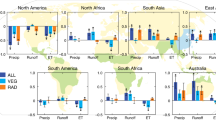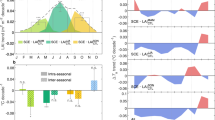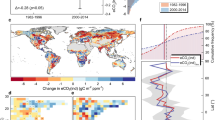Abstract
Anthropogenic increases in the atmospheric concentration of carbon dioxide and other greenhouse gases are predicted to cause a warming of the global climate by modifying radiative forcing1. Carbon dioxide concentration increases may make a further contribution to warming by inducing a physiological response of the global vegetation—a reduced stomatal conductance, which suppresses transpiration2. Moreover, a CO2-enriched atmosphere and the corresponding change in climate may also alter the density of vegetation cover, thus modifying the physicalcharacteristics of the land surface to provide yet another climate feedback3,4,5,6. But such feedbacks from changes in vegetation structure have not yet been incorporated into general circulation model predictions of future climate change. Here we use a general circulation model iteratively coupled to an equilibrium vegetation model to quantify the effects of both physiological and structural vegetation feedbacks on a doubled-CO2 climate. On a global scale, changes in vegetation structure are found to partially offset physiological vegetation–climate feedbacks in the long term, but overall vegetation feedbacks provide significant regional-scale effects.
This is a preview of subscription content, access via your institution
Access options
Subscribe to this journal
Receive 51 print issues and online access
$199.00 per year
only $3.90 per issue
Buy this article
- Purchase on Springer Link
- Instant access to full article PDF
Prices may be subject to local taxes which are calculated during checkout



Similar content being viewed by others
References
Houghton, J. T. et al. (eds) Climate Change 1995(Cambridge Univ. Press, (1995)).
Sellers, P. J. et al. Comparison of radiative and physiological effects of doubled atmospheric CO2on climate. Science 271, 1402–1406 (1996).
Lean, J. & Rowntree, P. R. AGCM simulation of the impact of Amazonian deforestation on climate using an improved canopy representation. Q. J. R. Meteorol. Soc. 119, 509–530 (1993).
Bonan, G. B., Pollard, D. & Thompson, S. L. Effects of boreal forest vegetation on global climate. Nature 359, 716–718 (1992).
Foley, J. A., Kutzbach, J. E., Coe, M. T. & Levis, S. Feedbacks between climate and boreal forests during the Holocene epoch. Nature 371, 52–54 (1994).
Gallimore, R. G. & Kutzbach, J. E. Role of orbitally induced changes in tundra area in the onset of glaciation. Nature 381, 503–505 (1996).
Woodward, F., Smith, T. M. & Emanuel, W. R. Aglobal land primary productivity and phytogeography model. Glob. Biogeochem. Cycles 9, 471–490 (1995).
Mitchell, J. F. B., Johns, T. C., Gregory, J. M. & Tett, S. F. B. Climate response to increasing levels of greenhouse gases and sulphate aerosols. Nature 376, 501–504 (1995).
Jones, R. G., Murphy, J. M. & Noguer, M. Simulation of climate change over Europe using a nested regional-climate model. I: Assessment of control climate, including sensitivity to location of lateral boundaries. Q. J. R. Meteorol. Soc. 121, 1413–1449 (1995).
Senior, C. A. & Mitchell, J. F. B. Carbon dioxide and climate: the impact of cloud parameterization. J. Clim. 6, 393–418 (1993).
Chen, T. H. et al. Cabauw experimental results from the project for intercomparison of land-surface schemes (PILPS). J. Clim.(in the press).
Rowntree, P. R. & Bolton, J. A. Simulation of the atmospheric response to soil moisture anomalies over Europe. Q. J. R. Meteorol. Soc. 109, 501–526 (1983).
Beljaars, A. C. M., Viterbo, P., Miller, M. J. & Betts, A. K. The anomolous rainfall over the United States during July 1993: sensitivity to land surface parameterization and soil moisture anomalies. Mon. Weath. Rev. 124, 362–383 (1996).
Milly, P. C. D. & Dunne, K. A. Sensitivity of the global water cycle to the water-holding capacity of land. J. Clim. 7, 506–526 (1994).
Rowntree, P. R. in Land Surface Evaporation(eds Schmugge, T. J. & Andre, J. C.) 5–30 (Springer, New York, (1991)).
Wilson, M. F. & Henderson-Sellers, A. Aglobal archive of land cover and soils data for use in general circulation climate models. J. Climatol. 5, 119–143 (1985).
Sellers, P. J., Mitz, Y., Sud, Y. C. & Dalcher, A. Asimple biosphere model (SiB) for use within general circulation models. J. Atmos. Sci. 43, 505–531 (1986).
Lowry, W. P. & Lowry, P. P. Fundamentals of Biometeorology. Interactions of Organisms and the Atmosphere Vol. 1 (Peavine, McMinnville, OR, (1989)).
Eagleson, P. S. Dynamic Hydrology(McGraw Hill, New York, (1970)).
Halldin, S., Saugier, B. & Pontailler, F. Y. Evapotranspiration of a deciduous forest. Simulation using routine meteorological data. J. Hydrol. 75, 323–341 (1984).
Shaw, R. H. & Pereira, A. R. Aerodynamic roughness of a plant canopy. Agricult. Meterol. 26, 51–65 (1982).
Acknowledgements
We thank E. M. Blyth, J. Foley, R. J. Harding, W. J. Ingram, J. E. Lovelock, J. F. B. Mitchell, P. L. Mitchell, P. R. Rowntree, C. A. Senior, W. J. Shuttleworth, S. F. B. Tett and P. J. Valdes for comments, advice and discussion. This work was supported by the NERC TIGER programme and the UK Department of the Environment.
Author information
Authors and Affiliations
Additional information
Correspondence and requests for materials should be addressed to R.A.B.
Rights and permissions
About this article
Cite this article
Betts, R., Cox, P., Lee, S. et al. Contrasting physiological and structural vegetation feedbacks in climate change simulations. Nature 387, 796–799 (1997). https://doi.org/10.1038/42924
Received:
Accepted:
Issue Date:
DOI: https://doi.org/10.1038/42924
This article is cited by
-
Soil–vegetation moisture capacitor maintains dry season vegetation productivity over India
Scientific Reports (2023)
-
Projected increase in global runoff dominated by land surface changes
Nature Climate Change (2023)
-
The intensification of Arctic warming as a result of CO2 physiological forcing
Nature Communications (2020)
-
The response of vegetation to rising CO2 concentrations plays an important role in future changes in the hydrological cycle
Theoretical and Applied Climatology (2019)
-
Aspects of Forest Biomass in the Earth System: Its Role and Major Unknowns
Surveys in Geophysics (2019)
Comments
By submitting a comment you agree to abide by our Terms and Community Guidelines. If you find something abusive or that does not comply with our terms or guidelines please flag it as inappropriate.



